NVIDIA GeForce GTX 760 Review: The New Enthusiast Kepler
by Ryan Smith on June 25, 2013 9:00 AM ESTOverclocking GTX 760
Like the GTX 770 last month, the GTX 760 is clocked relatively high. Its 980MHz base clock is 65MHz higher than either the GTX 670 or GTX 660 Ti. As a result some of the overclocking headroom that we would expect has been eaten into by the overclock. Yet on the other hand the higher voltage for the highest boost bin – 1.2v versus 1.175v – gives us some additional overclocking headroom as long as our cooling can keep up.
At the same time the GTX 760 gets a slightly larger TDP adjustment window than most other GK104 parts. Here we can push the TDP up by up to 15%, from 170W to 195W. This is actually more than the GTX 770, so in TDP limited scenarios we should have a slightly easier time hitting the higher boost bins.
| GeForce GTX 760 Overclocking | ||||
| Stock | Overclocked | |||
| Core Clock | 980MHz | 1130MHz | ||
| Boost Clock | 1033MHz | 1183MHz | ||
| Max Boost Clock | 1149MHz | 1306MHz | ||
| Memory Clock | 6GHz | 6.5GHz | ||
| Max Voltage | 1.2 | 1.212v | ||
In practice GTX 760 ended up exceeding our expectations. In fact it even ended up exceeding GTX 770 with regard to the size of the overclock and the highest boost bin we reached. Altogether we were able to increase the core clock by 150MHz on our GTX 760 sample, going from a base clock of 980MHz to 1130MHz. At the same time our max boost clock went from 1149MHz to 1306MHz, making this the first Kepler we’ve seen to surpass 1300MHz. The end result is that core overclocking ends up being more potent than we were expecting.
Meanwhile the memory overclock is fairly standard for a GK104 part. It’s something of a roll of the dice, and in this case we were able to hit 6.5GHz before memory performance started regressing. Thus we’re altogether looking at a 15% core overclock coupled with a milder 8% memory overclock.
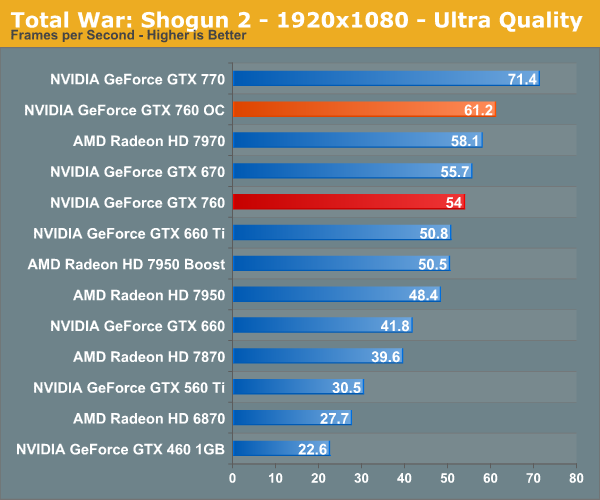
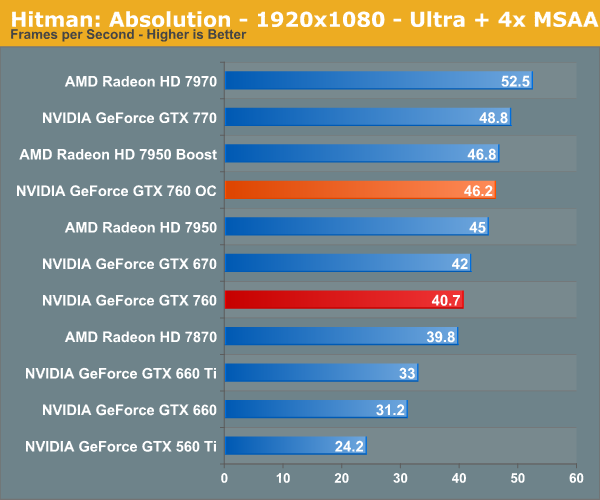
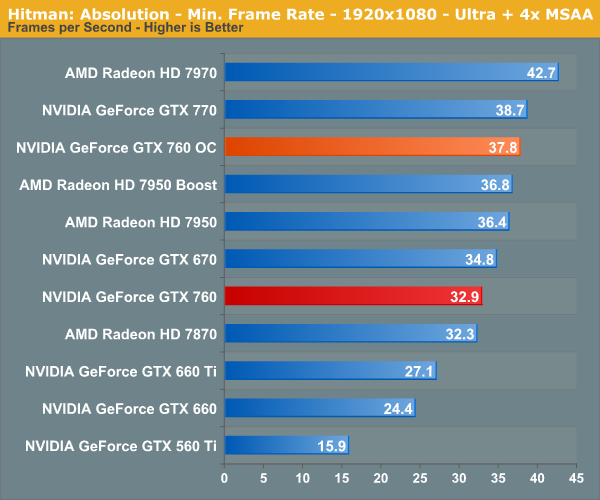
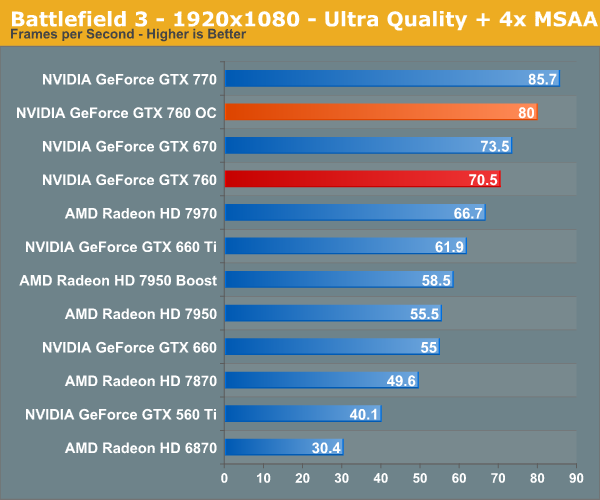
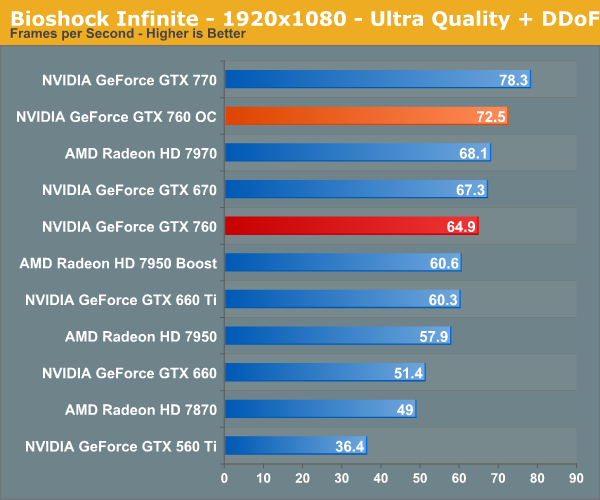
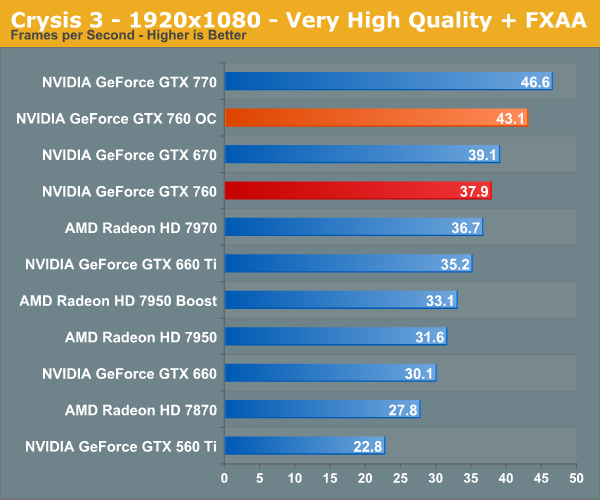
Given GTX 760’s base shader/texture performance deficit due to only having 6 SMXes, overclocking proves to be very effective on our final results. The performance gains in all 5 of our games were on the order of 12% to 14%, just a bit less than the core overclock itself. With the wide gap between the GTX 770 and GTX 760 in terms of specs this generally isn’t enough to completely catch up to NVIDIA’s top-tier GK104 card, but it can erase a large portion of the gap.
The end result of this overclock won’t dramatically change the GTX 760’s performance profile, but it should help to push it over 60fps in those situations where performance at 1080p at ultra quality settings was marginal. Or from a fixed performance standpoint, we’re approaching Radeon HD 7970 performance with this overclock.
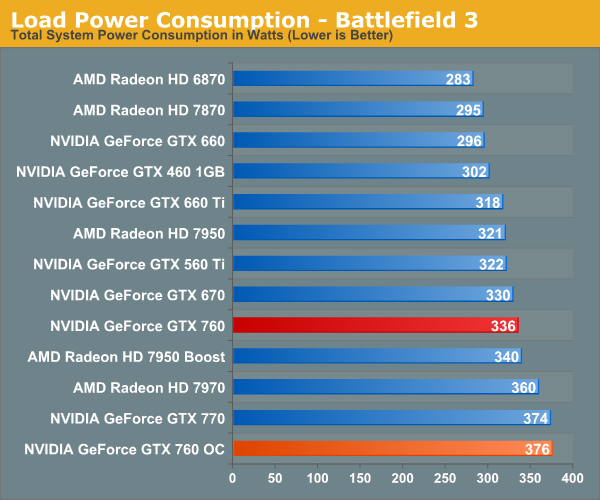
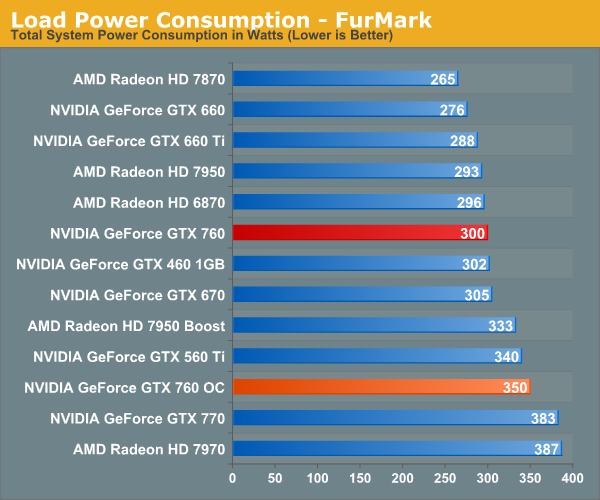
Moving on to power consumption, increasing our TDP has the expected hit. GTX 760 of course has a larger adjustment window than GTX 770, so the increase in power consumption ends up being noticeably larger. Overclocking in this manner pushes the GTX 760 off of the power/performance efficiency curve to some degree, so the GTX 760 loses its edge in that respect.
The end result is that power consumption at the wall jumps by 40W under BF3, and 50W under FurMark. This is tied with and better than the stock GTX 770 respectively, though as we’ve already seen it doesn’t match the GTX 770’s rendering performance. Furthermore as we’ll see, cooling is going to play a big factor here, with the reference GTX 760 cooler not always being the best choice for overclocking.
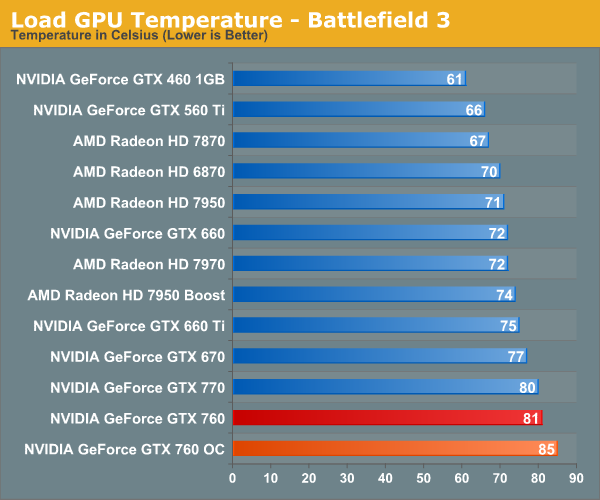
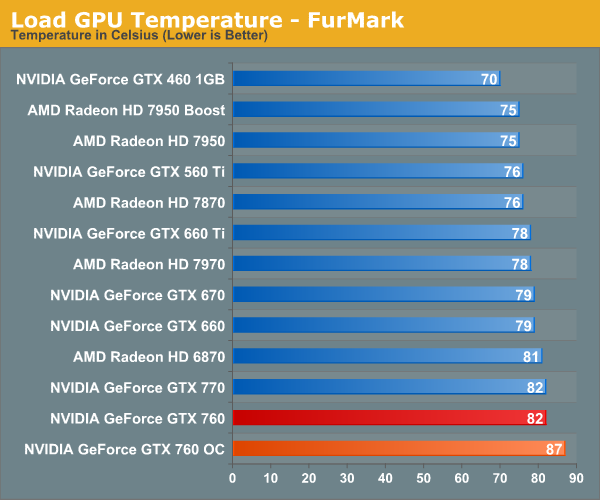
With the temperature limit raised to 95C, the reference GTX 760 cooler reaches equilibrium at 85C under BF3 and 87C under FurMark. These temperatures are still easily within spec for GK104, but they’re definitely starting to crawl up here. Meanwhile, though it’s not directly measurable the impact of leakage is certainly making itself felt here. If we had cooler temperatures power consumption would at least be marginally lower.
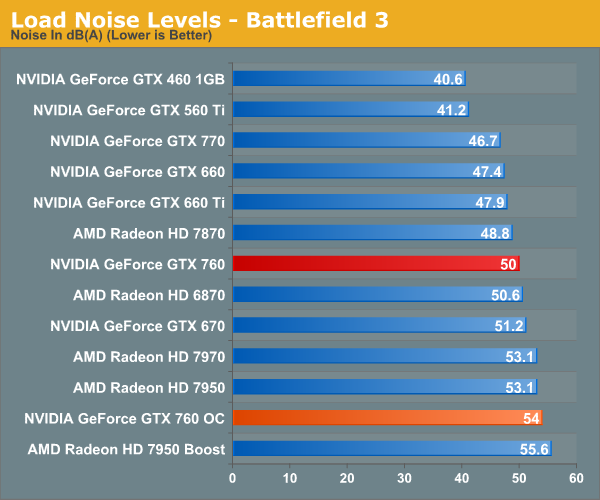
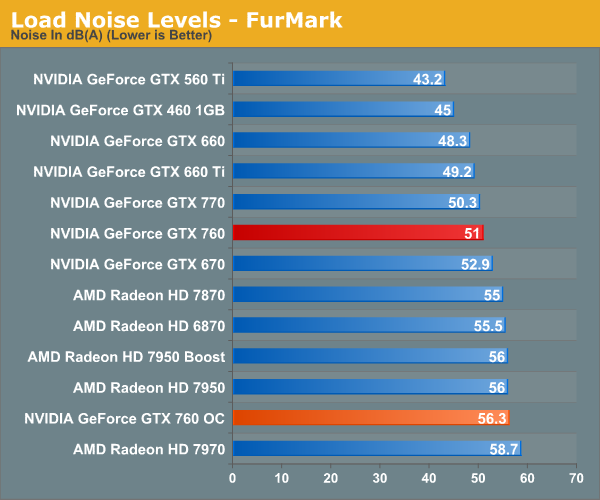
Finally we noise we can see that those new equilibriums also come at new, much higher noise levels. The reference cooler can keep up with the higher heat load created by overclocking, but it’s having to work hard to do so. These noise levels aren’t terrible – in fact they’re about even with the reference 7950 – but they do represent a real cost in terms of noise. Consequently, unlike NVIDIA’s Titan cooler that comes with the reference Titan, GTX 780, and GTX 770, when it comes to GTX 760 there’s very clearly room for improvement with custom coolers.










110 Comments
View All Comments
Aditya211935 - Tuesday, June 25, 2013 - link
I guess I m a bit early.A5 - Tuesday, June 25, 2013 - link
Looks pretty solid for the price.Samus - Tuesday, June 25, 2013 - link
I feel like an idiot buying a 660Ti two months ago for $300. At least I got the 3GB version that'll be "somewhat" future-proof for BF4 as the maps are expected to tax 2GB cards.gamoniac - Tuesday, June 25, 2013 - link
Don't look back. You can only make your decision based on the information you had and your needs at the time. If you could look just 2 minutes ahead, you would be a billionaire now and wouldn't be participating in this conversation.just4U - Tuesday, June 25, 2013 - link
this is essentially a cheaper 670.. coming it at or below the price of the 660TI. I don't see your purchase as being one of those you think $*!@! over. Hah. Your card is a bit slower but not noticeably so and the added ram may benefit you down the road.Hixbot - Wednesday, June 26, 2013 - link
A cheaper, and slower 670. So not really a 670 at all.just4U - Tuesday, June 25, 2013 - link
I'd agree.. although pricing here is 275-300.. Don't see any at 249. The 7950 is 300.. They will have to lower that down a tiny bit to be competitive I think, take a small hit in performance (but more ram possible benefit later?) and their games bundle the trade off for consumers should be about equal.Lovolt - Wednesday, June 26, 2013 - link
Not sure where 'here' is, but newegg has 3 models at $250 and another 6 at $260 (on June 26).just4U - Thursday, June 27, 2013 - link
Calgary Canada.. We have a newegg.ca but it's not as good as your newegg I think that's to do with taxation and not having a actual warehouse here.ericore - Tuesday, July 2, 2013 - link
No, they have warehouses in Canada; if you've ever ordered a big order you'd realize this since not everything ships at once; comes from different warehouses in Vancouver, Mississauga and several others. They charge us more because they can, but only charge more on certain items so that we can't revolt. Generally the can prices are very close to the US ones, but the odd time they are significantly more. Processing and taxes are also cheaper in the US, but we do get the crappy end of the stick at times. There was a specialty motherboard, on newegg.com this was 100, and newegg.ca this was 150; can't remember the model.